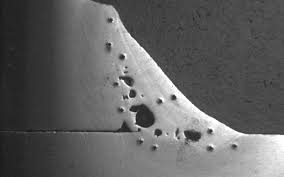Specialist Recommendations on What is Porosity in Welding and Just How to Resolve It
Specialist Recommendations on What is Porosity in Welding and Just How to Resolve It
Blog Article
The Scientific Research Behind Porosity: A Comprehensive Guide for Welders and Fabricators
Understanding the detailed mechanisms behind porosity in welding is critical for welders and fabricators aiming for flawless workmanship. From the composition of the base materials to the ins and outs of the welding procedure itself, a wide range of variables conspire to either aggravate or minimize the presence of porosity.
Recognizing Porosity in Welding
FIRST SENTENCE:
Exam of porosity in welding reveals important understandings right into the honesty and quality of the weld joint. Porosity, characterized by the presence of tooth cavities or spaces within the weld steel, is an usual problem in welding procedures. These gaps, if not correctly addressed, can compromise the structural integrity and mechanical residential properties of the weld, bring about prospective failures in the finished item.

To find and measure porosity, non-destructive testing methods such as ultrasonic screening or X-ray assessment are typically employed. These techniques permit for the identification of inner flaws without endangering the integrity of the weld. By analyzing the size, shape, and circulation of porosity within a weld, welders can make educated choices to enhance their welding procedures and attain sounder weld joints.

Variables Influencing Porosity Development
The event of porosity in welding is influenced by a myriad of variables, ranging from gas securing efficiency to the details of welding parameter settings. Welding specifications, consisting of voltage, current, travel speed, and electrode kind, additionally impact porosity formation. The welding method utilized, such as gas steel arc welding (GMAW) or secured steel arc welding (SMAW), can influence porosity formation due to variants in warm distribution and gas coverage - What is Porosity.
Results of Porosity on Weld Quality
The presence of porosity also weakens the weld's resistance to corrosion, as the entraped air or gases within the spaces can react with the surrounding environment, leading to degradation see this page over time. Additionally, porosity can prevent the weld's capacity to hold up against stress or effect, further threatening the overall top quality and integrity of the welded framework. In crucial applications such as aerospace, vehicle, or structural building and constructions, where security and durability are extremely important, the damaging effects of porosity on weld high quality can have severe repercussions, highlighting the importance of lessening porosity through correct welding techniques and procedures.
Strategies to Reduce Porosity
In addition, utilizing the suitable welding parameters, such as the correct voltage, present, and take a trip rate, is crucial in avoiding porosity. Preserving a regular arc length and angle throughout welding additionally helps decrease the possibility of porosity.

Moreover, choosing the best protecting gas and preserving appropriate gas flow prices are important in minimizing porosity. Utilizing the appropriate welding technique, such as back-stepping or employing a weaving activity, can additionally assist disperse warmth why not check here equally and lower the possibilities of porosity development. Last but not least, making sure appropriate ventilation in the welding environment to remove any kind of possible resources of contamination is crucial for accomplishing porosity-free welds. By executing these strategies, welders can successfully reduce porosity and produce high-quality bonded joints.

Advanced Solutions for Porosity Control
Implementing advanced innovations and cutting-edge techniques plays a critical role in attaining remarkable control over porosity in welding procedures. One innovative remedy is the use of innovative gas blends. Securing gases like helium or a blend of argon and hydrogen can help in reducing porosity by providing better arc security and boosted gas coverage. Furthermore, employing advanced welding techniques such as pulsed MIG welding or modified atmosphere welding can also help minimize porosity problems.
One more advanced solution entails using sophisticated welding equipment. Making use of equipment with built-in functions like waveform control and innovative power sources can boost weld top quality and minimize porosity risks. Additionally, the execution of automated welding systems with exact control over specifications can dramatically reduce porosity defects.
Furthermore, incorporating advanced surveillance and inspection modern technologies such as real-time X-ray imaging or automated ultrasonic screening can assist in detecting porosity early in the welding process, permitting prompt rehabilitative activities. Generally, incorporating these sophisticated services can significantly boost porosity control and improve the general quality of bonded parts.
Verdict
In verdict, comprehending the science behind porosity in welding is crucial for welders and makers to create premium welds. By identifying the factors affecting go to my site porosity formation and implementing methods to reduce it, welders can improve the general weld top quality. Advanced services for porosity control can even more enhance the welding process and guarantee a strong and reliable weld. It is very important for welders to constantly inform themselves on porosity and apply ideal methods to accomplish ideal results.
Report this page